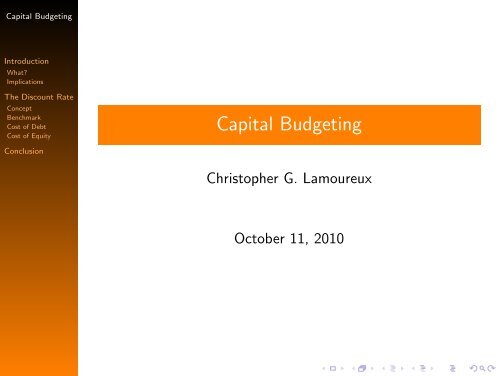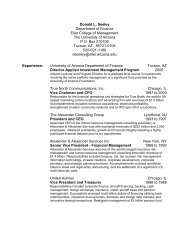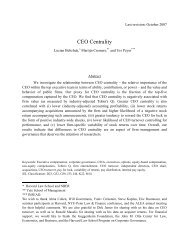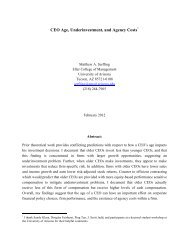Talk to Fin 512 on Capital Budgeting (October 11, 2010).
Talk to Fin 512 on Capital Budgeting (October 11, 2010).
Talk to Fin 512 on Capital Budgeting (October 11, 2010).
- No tags were found...
You also want an ePaper? Increase the reach of your titles
YUMPU automatically turns print PDFs into web optimized ePapers that Google loves.
<strong>Capital</strong> <strong>Budgeting</strong>PuzzlesIntroducti<strong>on</strong>What?Implicati<strong>on</strong>sThe Discount RateC<strong>on</strong>ceptBenchmarkCost of DebtCost of EquityC<strong>on</strong>clusi<strong>on</strong><strong>Capital</strong> should be unc<strong>on</strong>strained. If we have a positive NPVproject that means (definiti<strong>on</strong>ally) that we should be able <str<strong>on</strong>g>to</str<strong>on</strong>g>finance the project in the marketplace. If that is not true,then we are using the wr<strong>on</strong>g discount rates.In practice: <strong>Capital</strong> expenditures are highly politicized.Q: So, how can capital be c<strong>on</strong>strained?A: You are not taking <strong>on</strong> positive NPV projects.(Furthermore, the <strong>on</strong>ly reas<strong>on</strong> you need a capital budget is<str<strong>on</strong>g>to</str<strong>on</strong>g> artificially rati<strong>on</strong> activity across the organizati<strong>on</strong>. It is animplicit recogniti<strong>on</strong> of the fact that the budget processelicits lies.)
<strong>Capital</strong> <strong>Budgeting</strong>Soluti<strong>on</strong>sIntroducti<strong>on</strong>What?Implicati<strong>on</strong>sThe Discount RateC<strong>on</strong>ceptBenchmarkCost of DebtCost of EquityC<strong>on</strong>clusi<strong>on</strong>Eliminate the whole noti<strong>on</strong> of capital budget. Tie-inoperati<strong>on</strong>al budgets with capital usage.An example of this thinking is Stern-Stewart’s Ec<strong>on</strong>omicValue Added. Charge each manager for capital at currentmarket costs. Evaluate managers by the (ec<strong>on</strong>omic) ROA.The design of the budget process and the effect it has <strong>on</strong>incentives is much more important than the details of howprojects are evaluated.
<strong>Capital</strong> <strong>Budgeting</strong>The IdeaIntroducti<strong>on</strong>What?Implicati<strong>on</strong>sThe Discount RateC<strong>on</strong>ceptBenchmarkCost of DebtCost of EquityC<strong>on</strong>clusi<strong>on</strong>The c<strong>on</strong>cepts are:◮ M<strong>on</strong>ey in future is less valuable than m<strong>on</strong>ey <str<strong>on</strong>g>to</str<strong>on</strong>g>day.◮ Discount rates must reflect relevant risks–as priced inthe capital markets.◮ So this implies that you should know the financing mix.Now the questi<strong>on</strong>s are:◮ What financing mix?◮ Which market costs?
<strong>Capital</strong> <strong>Budgeting</strong>Easy CaseIntroducti<strong>on</strong>What?Implicati<strong>on</strong>sThe Discount RateC<strong>on</strong>ceptBenchmarkCost of DebtCost of EquityC<strong>on</strong>clusi<strong>on</strong>For example, let’s c<strong>on</strong>sider a benchmark case:◮ The company is publicly traded, is a pure-play, and itscapital structure is optimal.◮ The questi<strong>on</strong> of the specific source of funds is irrelevant(e.g., whether there is enough cash <strong>on</strong> hand, . . . )So using the (marginal) after-tax weighted average cost ofcapital is akin <str<strong>on</strong>g>to</str<strong>on</strong>g> a direct market test. Of course, in practice,the company exists because of some sort of market failure.As an example from Pi<strong>on</strong>eer Petroleum, different divisi<strong>on</strong>s inthe company have very different risk profiles. So the use of asingle wacc across the divisi<strong>on</strong>s is inappropriate.
<strong>Capital</strong> <strong>Budgeting</strong>DebtIntroducti<strong>on</strong>What?Implicati<strong>on</strong>sThe Discount RateC<strong>on</strong>ceptBenchmarkCost of DebtCost of EquityC<strong>on</strong>clusi<strong>on</strong>At the optimal capital structure, what is the yield <str<strong>on</strong>g>to</str<strong>on</strong>g>maturity <strong>on</strong> newly issued 30-year debt?Statu<str<strong>on</strong>g>to</str<strong>on</strong>g>ry marginal tax rate will probably overstate the taxbenefits of debt. In the event of losses, these carry-forward.In the event of bankruptcy these may be lost.
<strong>Capital</strong> <strong>Budgeting</strong>EquityIntroducti<strong>on</strong>What?Implicati<strong>on</strong>sThe Discount RateC<strong>on</strong>ceptBenchmarkCost of DebtCost of EquityC<strong>on</strong>clusi<strong>on</strong>Key c<strong>on</strong>cept in cost of equity is that <strong>on</strong>ly systematic risk ispriced in the market. So the <strong>on</strong>ly risk <str<strong>on</strong>g>to</str<strong>on</strong>g> which you exposeyour (diversified) shareholders is that which they cannotdiversify.Pi<strong>on</strong>eer Petroleum noti<strong>on</strong> of EBITDA yield (i.e., last year’sEBITDA divided by the s<str<strong>on</strong>g>to</str<strong>on</strong>g>ck price) is good for stable firms.Other approaches include CAPM and Fama-French fac<str<strong>on</strong>g>to</str<strong>on</strong>g>rmodel.(There are no tax benefits <str<strong>on</strong>g>to</str<strong>on</strong>g> equity.)
<strong>Capital</strong> <strong>Budgeting</strong>Take AwayIntroducti<strong>on</strong>What?Implicati<strong>on</strong>sThe Discount RateC<strong>on</strong>ceptBenchmarkCost of DebtCost of EquityC<strong>on</strong>clusi<strong>on</strong>A public company has <str<strong>on</strong>g>to</str<strong>on</strong>g> have a value culture. It is theCFO’s job <str<strong>on</strong>g>to</str<strong>on</strong>g> create this culture and ensure that thecomm<strong>on</strong> language driving all decisi<strong>on</strong>s is value optimizati<strong>on</strong>.As c<strong>on</strong>cerns capital budgeting this implies that there shouldnot be a capital budget. Whoever is resp<strong>on</strong>sible for investingcapital should be charged with earning a return <strong>on</strong> thatinvestment that increases the value of the claims <strong>on</strong> the firm.









